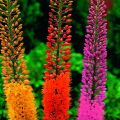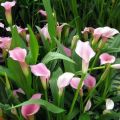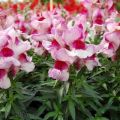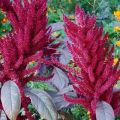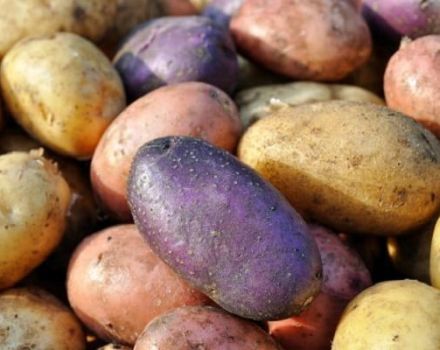Planting and caring for the crested in the open field, a description of the 28 best species and varieties
After planting the corydalis in open ground, due attention should be paid to caring for the plant. Each type of perennial plant differs in terms of flowering, color and shape, bush height. Recommendations will help prevent mistakes during the preparation of planting material and its planting. Care consists in establishing an irrigation regime, in the timely introduction of fertilizing, processing bushes from infections and pests, and some other measures.
Description and features
Corydalis is considered a herbaceous perennial plant. The name is due to the unusual shape of the flowers, which resemble a bird's crest. The flower is resistant to low temperatures and diseases, does not require special attention and has healing properties.
Corydalis has the following features:
- a powerful root system extends far into the depths and has several branches, in some varieties tubers appear on the roots;
- stem erect, fleshy, 17-36 cm high;
- the leaves are deep green in color and 2-3 cuts, resemble fern leaves;
- active growth of the bush begins in March;
- a brush of inflorescences is formed in the upper part of the stem;
- each flower has an oblong base that ends with petals curved outward;
- flowers can be yellow, pink, purple, blue or white;
- flowering lasts three weeks;
- after flowering, the fruit remains in the form of a pod;
- insects with a long proboscis can pollinate flowers.
Corydalis-based decoctions and infusions can relieve inflammation, reduce pain, and stop bleeding.

Kinds
There are more than 300 species of Corydalis. In areas with a temperate climate, the following plant varieties are most common.
Dense
The stem of the bush stretches up to 20 cm. The tubers are small, no more than 14 mm in diameter. From the lower part of the stem, two oblong bright green leaves with a double dissection depart. The buds begin to bloom in late April. The flowers are bright pink-purple in color.
Hollow
The plant forms a bush up to 38 cm high.The leaf plate is triangular, the edges are strongly feathery. The flowers open in a bright purple color.
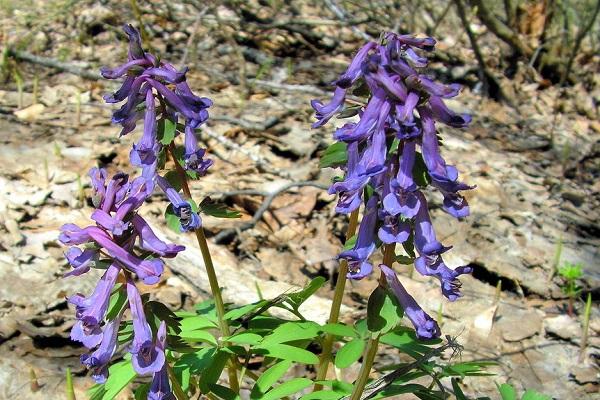
Marshall
A distinctive feature is the color of the stem up to 24 cm long. It is red-green in color. The height of the bush is not more than 27 cm. The leaves are green with a bluish tinge, divided into three parts. Inflorescences are yellowish.
Dubious
The stem is small, only 13 cm high. The flowers have a cornflower blue hue. Flowering occurs in the second half of April.
Noble
The plant grows to a height of 78 cm. The leaves are deep green, dissected. The buds bloom in the first half of May. The variety is distinguished by beautiful yellow flowers with purple edging.
Yellow
The stem of the plant extends upward by 36 cm. Green leaves with a bluish tint extend from the base of the flower. Flowers bloom early, already in the first half of April. Their color is bright yellow.
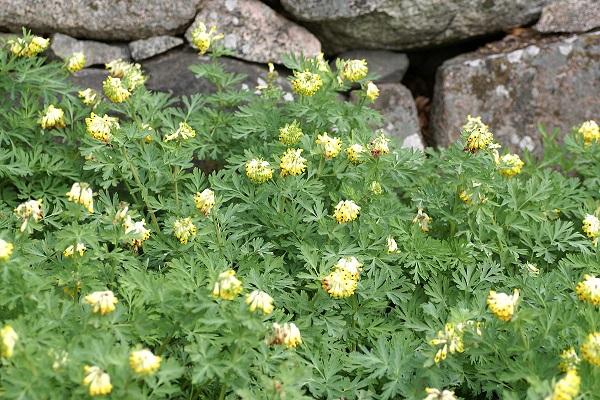
Chinese
The plant forms a bush up to 64 cm high. Leaves are bright green in color, with a bluish tint. Inflorescences are pale purple.
Mountain
The length of the peduncles does not exceed 22 cm. The tubers are formed with a diameter of up to 3 cm. The inflorescence in the form of a brush can accommodate up to 8 flowers of different colors. It begins to bloom in late May.
Alpine
The species is distinguished by an upright shoot, the next arrangement of leaves of bright green color. Leaves are complex, oval in shape with a pinnate dissection. The flowers are light blue.
Narrow-leaved
The plant is up to 18 cm high. The flowers are snow-white, medium-sized, up to 3 cm in diameter. It begins to bloom in late April.
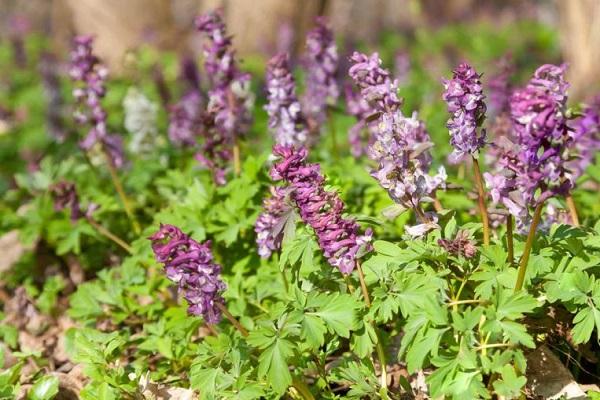
Intermediate
Erect shoots extend up to 72 cm high. The leaves are tubular, pale gray in color. The inflorescences are purple.
Low
The herbaceous plant is low, its height does not exceed 16 cm. It begins to bloom in the first half of May. In the inflorescence, up to 4 small flowers of pink-purple color are formed.
Large-flowered
A perennial herbaceous species of Corydalis is distinguished by the presence of rhizomes without tubers. The stem is thick, straight, up to 100 cm in height. The leaves are deep green, large. It begins to bloom in May.
Caucasian
The plant blooms early, in mid-April. The stem is low, up to 18 cm. Tubers are formed up to 3 cm in diameter. The flowers have a beautiful purple-pink color.
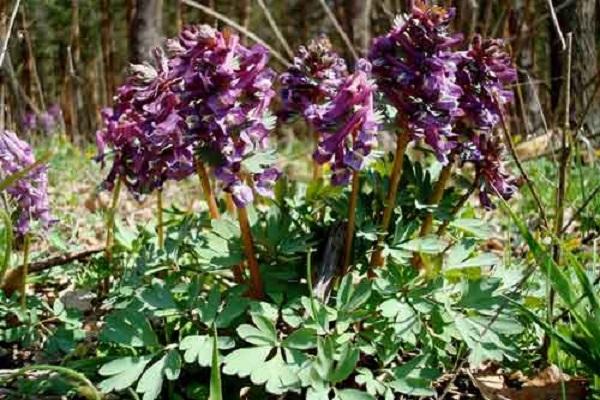
Haller
Stem height 19 cm. Root crops are formed up to 12 mm in diameter. Abundant flowering occurs in May. Green leaves are distinguished by a bluish tint, three-syllable form. Inflorescences are snow-white, purple, scarlet or pink.
Dissected
The plant looks like a fern because of the finely dissected leaves. Flowers in the inflorescence in the form of a brush are formed small, light yellow in color.
Sulfur yellow
The bush is not very high, up to 38 cm. The flowers bloom in a creamy yellow color. The leaves are deep green, strongly dissected. Flowering begins in May.
Noble
The herbaceous plant stretches up to 62 cm. The flowers are light yellow, with orange specks. The flower cluster opens at the end of May.

Sinuous
The corydalis species reaches a height of 36 cm. By the time of flowering, the peduncles stretch and begin to bend. Differs in bright blue fragrant inflorescences that appear in June.
High
The stalk of the corydalis of this species reaches 43 cm. Flowers of bright blue color are collected in a brush. It begins to bloom in the last days of May.
Average
The straight stem extends to a height of 14 cm. The inflorescences of lilac or violet-pink color have an irregular shape, their length is 12 mm.
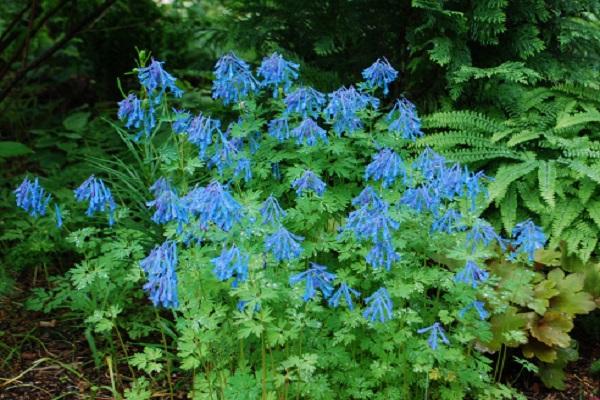
Popular varieties
All varieties of Corydalis are characterized by beautiful flowering, pleasant smell and compact bush.
Blue Panda
The variety is distinguished by gray-green leaves and pale blue flowers. Flowering time falls on the end of May.
Pearl Leaf
The perennial plant is distinguished by delicate blue fragrant flowers.The leaves have an unusual split shape, are painted in gray-green color, which smoothly turns into a purple color. It begins to bloom in May.
China Blue
A perennial plant is distinguished by strongly dissected leaves and inflorescences of a pale blue hue.
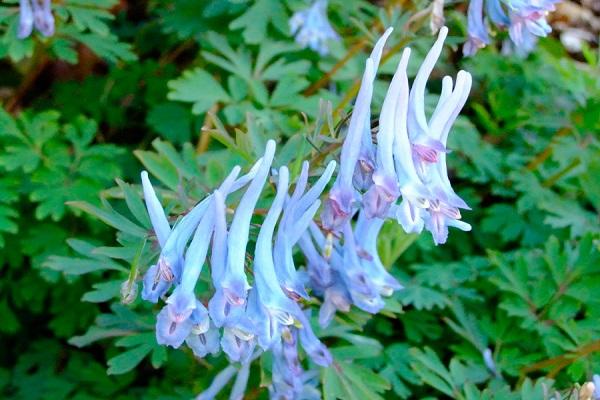
Balang Mist
The flowers of the plant are pale blue. It begins to bloom in late May. Leaves of deep green color with carved edges.
Blue heron
The beautiful variety is distinguished by its bright blue flowers. Cirrus leaves are green with a purple tint. It begins to bloom in May.
Blue line
The compact perennial plant blooms with beautiful deep blue flowers with a pleasant aroma. Leaves are repeatedly dissected.
Beth Evans
The variety differs in bright pink inflorescences. The leaves are juicy green. The height of the bush does not exceed 28 cm.
Gp baker
Corydalis Baker blooms in May. The flowers are bright pink, fragrant. Openwork leaves of an oval shape and green color.
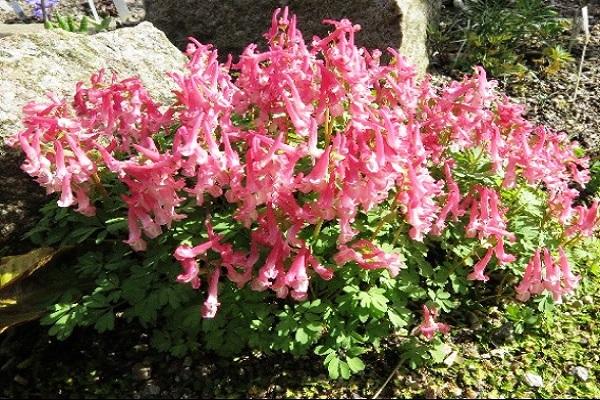
How to plant
In order for the flowering to be bright and long, you should choose the right site for planting and prepare the planting material.
Selection and preparation of seed
Corydalis seeds, even in good conditions, quickly lose their germination, so they start sowing within the first five days after collection.
When growing seeds for seedlings, you should adhere to the following rules:
- the container is covered with peat and sand;
- seeds are evenly distributed over the entire surface and covered with sand;
- then moisten the soil with a spray bottle and cover the container with a film;
- in the first year after planting, only leaves will appear, but strong shoots should have grown by spring.
Before planting tubers, they should be carefully examined. Only dense and juicy specimens are suitable for planting.
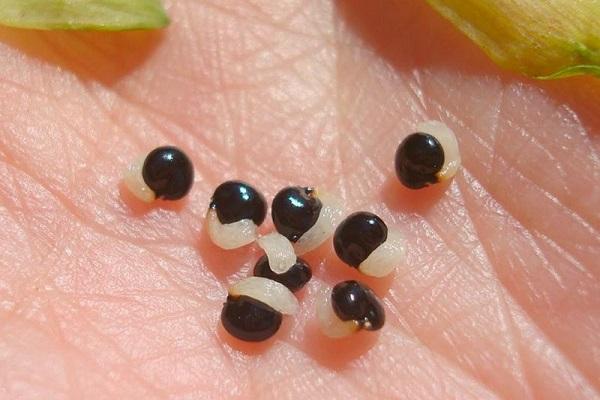
Timing
Ready seedlings begin to be transplanted to an open area only at the end of May, when the threat of night frosts is over, and the soil warms up to +15 degrees.
It is permissible to plant tubers from the second half of June to September. At this time, the tubers are dormant.
Site selection
For planting Corydalis, choose a well-lit area in the garden, which will be protected from through winds. At the same time, water should not stagnate in the soil. The soil should be nutritious, light, with low acidity and good aeration. If the soil is heavy, then coarse sand must first be added.
Landing rules
Planting tubers is best done during flowering. If the tubers are large, then they are deepened into the ground by 14 cm with an interval of 12 cm.If the tubers are small, then the planting depth is reduced to 6 cm.
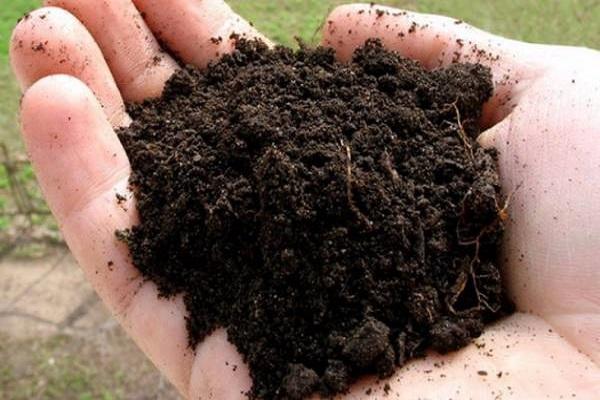
Care
When growing a corydalis on a land plot, you should organize regular watering, do not forget to weed and loosen the soil, apply fertilizers, and protect against diseases and pests.
Watering
The period of active growth occurs in the first spring months. At this time, the soil is still moist and no additional moisture is required. As soon as the earth dries up, watering is carried out systematically. It is important to avoid stagnation of moisture in the soil.
After watering, the soil is loosened. The procedure prevents the formation of dry crust on the soil surface. In addition, due to loosening, air and nutrients are fully supplied to the roots of the plant.
Weeds should not be allowed to grow. They increase the risk of spreading fungal infections and pests. It is best to mulch the soil around the flowers.

Top dressing
If the corydalis is planted in a nutrient soil, then additional fertilization is not required. To increase the fertility of the soil, organic matter is introduced into the soil before planting the corydalis.
After flowering
After the end of the flowering stage, the leaves and stem of the plant turn yellow, wither and die off. To remember the place where the corydalis bushes grew, pegs are placed near them.
Wintering
Almost all corydalis species tolerate low temperatures in winter.But some varieties require additional cover. Therefore, they are covered with fallen leaves, sawdust, pine branches, peat.
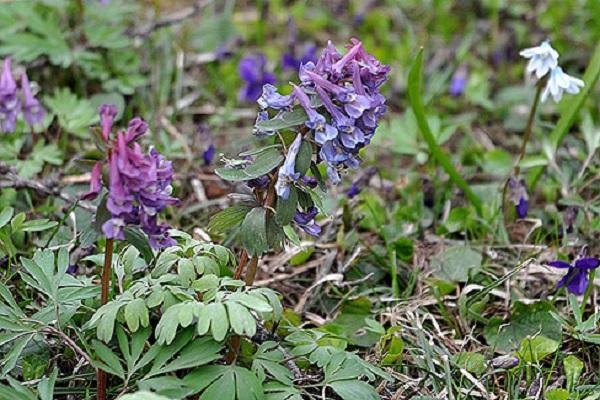
Transplant and reproduction
It is best to do a flower transplant during the rest period, but during the flowering period the plant tolerates the procedure well. The bushes are dug up and transferred along with a lump of earth to a new prepared area.
Corydalis propagation occurs by seeds, tubers or by dividing the bush:
- Rhizome division begins in the spring months or in the middle of summer. The bush is dug out of the ground and divided into parts. It is important that each separated part has a bud and a part of the rhizome. The bush is planted to a depth of 8 cm, observing an interval of 12 cm.
- The seed option involves sowing unripe flower seeds. Therefore, you need to try to collect material when the box is still greenish. Otherwise, it cracks, and the seeds spill out on the ground.
Diseases and pests
The Corydalis has good immunity. But in the case of stagnant moisture in the root zone, the risk of developing fungal diseases increases.

Viruses
Viruses can be recognized by the presence of spots and growths on the leaves. They curl, turn yellow and dry. Bushes infected with the virus should be removed from the site and burned. After that, the earth is spilled with a solution of potassium permanganate.
Rust
A fungal disease such as rust is recognized by brown and brown convex spots on the leaves and stem of the plant. Gradually, the plant turns yellow and withers. Such drugs as "Topaz", "Baktofit", "Atlant" help to fight the disease.
Moles and mice
Rodents damage plant roots and stems. Various methods are used to combat pests: pesticides are used, ultrasonic repellents or traps are installed.
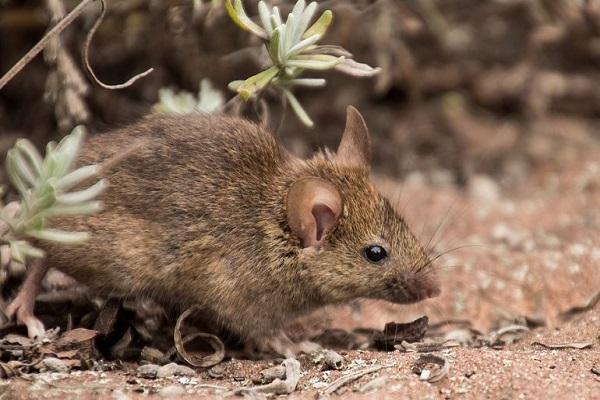
Slugs
Traces of the movement of pests in the form of mucus remain on the plant. They eat the leaves and cause the flower to wilt. In order to prevent their appearance, you should get rid of weeds in time and loosen the ground. If slugs appear, they are caught by hand or traps are set.
Bulb nematode
Adult worms reach 1.9 mm in length. Their activity leads to the fact that the plant turns yellow and dries up, the tubers crack and become loose. Against parasites, a drug such as "Meliorant Percalcite" helps well.
Use in landscape design
Corydalis will be a wonderful decoration for any flower bed and flower garden. The plant becomes a wonderful addition to flower arrangements on alpine hills and rocky gardens.


